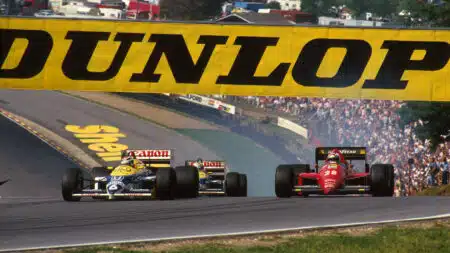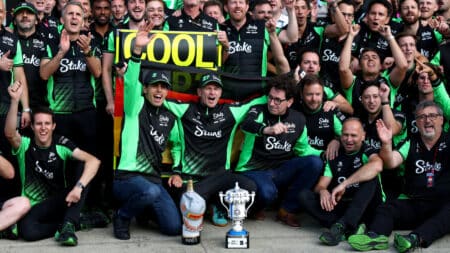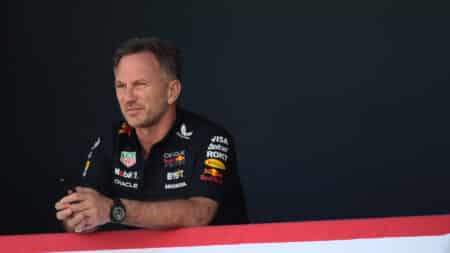
Brands Hatch: F1's beloved countryside amphitheatre
On this day in 1964, the roar of F1 engines echoed through the Kent countryside for the first time, as Brands Hatch made its debut on the world stage
McLaren’s apparent competitiveness in the season-opening Australian Grand Prix has turned out to be a false dawn. Now that we’ve been to a couple more aerodynamically demanding tracks than Albert Park it’s very apparent that the MP4-29 has a serious downforce shortfall – just as did its predecessor.
In hindsight the respective second and third places (post Daniel Ricciardo’s disqualification from second) of Kevin Magnussen and Jenson Button in Australia was flattered by the traits of the track favouring McLaren’s potent Mercedes power unit. It was also respectable around the similar demands of Bahrain, where Button might have taken a podium had mechanical failure not intervened.
But around both Malaysia and China – more flowing, fast, long-corner tracks placing heavy emphasis on high speed downforce – the car was mediocre at best. Given a clear run unimpeded by traffic, Button finished 57sec behind Sebastian Vettel’s Red Bull in Sepang, despite a big power advantage.

If the Mercedes power unit is worth 0.7sec over that of the Red Bull’s Renault (which seems to be generally accepted) then the implication was that the McLaren chassis was 1.7sec per lap slower than the Red Bull’s over the course of the race. It can get closer than that in qualifying, but that’s before the greater tyre degradation of a downforce-light car begins playing its part.
For those misguided enough to believe it’s all down to drivers, consider that Button’s average qualifying deficit to Lewis Hamilton was 0.15sec in their three seasons together – and the current deficit of the chassis appears to be over 10 times that. The competitive void is desperately bigger than any change of driver could bring.
On the eve of the Spanish Grand Prix around perhaps the most aerodynamically demanding track on the calendar, the messages from inside the team were not those of confidence, despite an expected aero upgrade package.

Button: “The Circuit de Catalunya is a demanding race track for any car – its combination of long, sweeping corners places the emphasis on aerodynamic performance, which is an area where we’re lacking at the moment. It’s always been a place where a competitive car will shine and a less-competitive one will struggle.
“For us, it’s not simply about bringing new parts to the circuit: it’s about understanding and unlocking the car’s secrets, and using that understanding to take bigger steps with performance. We’re still at the early stages with our car, and, for us, it’s less about the components that we fit to it, and more about the bigger picture – finding a useful direction, gaining trust in our measurements and pushing ahead.
“We all know that this team has the capacity to develop a car through a season, so I hope and trust that we’ll start to push forwards again soon.”
From sporting director Eric Boullier: “The root of our under-performance has been comprehensively analysed; we know the areas where our package falls short, and we’ve taken steps – both short- and long-term – to address those. While not all of those will be in evidence in Barcelona this weekend, they mark the start of a fresh push and spirit within the whole organisation.”

Jenson Button
Australia: 3rd
Malaysia: 6th
Bahrain: 17th
China: 11th
Kevin Magnussen
Australia: 2nd
Malaysia: 9th
Bahrain: Ret
China: 13th
There’s a clear ‘don’t expect anything great from us this weekend’ message there. But changes are underway, not just to the car but to the way the whole organisation works. Given that McLaren exists to win, that its whole structure and cost base is formulated around regularly winning Grands Prix and fighting for world championships, producing a duff car two seasons in a row is a very worrying development.
It suggests that something within the organisation is not functioning as it should – aligning very much with the premise of Ron Dennis as he retook control of the team after five years away.
Certainly, there has been a lot of disruption among key technical personnel at McLaren in the last couple of years. Quite aside from the departure of Paddy Lowe to Mercedes in 2013, a whole coterie of engineers seem to be caught in a loop between McLaren and Ferrari.
Nic Tombassis and John Iley each bounced between Woking and Maranello like pinballs, as did Marcin Budkowski whose CV reads Ferrari 2002-07, McLaren 2008-11, Ferrari 2012, McLaren (as head of aero) 2013! Earlier this year a terse McLaren statement read: “Marcin Budkowski and McLaren Racing have differing views on the strategic plans affecting the aerodynamics department and as such we have agreed to part company.”

Peter Prodromou had by then already been confirmed as re-joining the team from Red Bull as the new head of aero. Dan Fallows meanwhile has been the subject of a tug-of-love between McLaren and Red Bull, though it now looks likely he will remain at Red Bull.
Now Lotus’s principal aerodynamicist Guillaume Cattelani and Sauber’s aero group leader Tony Salter are about to join a McLaren aero group that must feel at best unsettled at the moment but with some very clearly defined challenges ahead of it.
Underlying that is a change of emphasis in how the team functions, brought about by Dennis and Boullier. Martin Whitmarsh, fresh from British Aerospace in 1989, oversaw the team’s adoption of the matrix management concept, whereby people have more than one manager, according to the task they are doing.
Different engineers can be reporting to several different engineering managers, each of which is responsible for a particular discipline. Most of the bigger F1 teams employ such a system, though some more wholeheartedly than others. It has the theoretical advantage of spreading knowledge through the company, but it’s renowned as a difficult, complex system to make effective and in a racing team there are several obvious hazard points to it: it creates joint accountability and as such can make it easier for an individual to hide sub-par performance.

It’s actually not that great a structure for an organisation filled with hugely competitive people. Only the top levels of management can truly take the view that they are all collectively competing against the rest. From a career perspective, the others are also competing with each other and the matrix makes for an environment where there’s enough ambiguity for politics to muddy the waters of merit.
It’s a system that requires more managers, leading to a tendency to bureaucratise and more time spent – and more people involved in – decision making. It also can lead to stress as employees serve more than one boss and typically the turnover of staff increases.
Red Bull does not operate in this way. It’s what Mark Webber once described as a ‘big F3 team’ dedicated only to racing, making quick decisions and not getting too caught up in the chains of command. When Dennis gave his speech to the employees upon his return he said: “McLaren used to be a great race team, but over the past five years it’s become a good engineering company. It needs to become a great race team again.”

Boullier has described the change thus: “Once we have this leadership in place with clear strategy, then we have to make sure the communication flow within the company is maybe a little simpler to make it faster and better in the end. We think we will see the benefit of this during the course of this season, but definitely next year. Already this year we should see some drastic change though, first within the company – which is a kind of culture shift.”
McLaren is in the midst of structural and cultural change. It desperately needs to change whatever isn’t working, for it’s too big and committed to too much overhead to continue with its current level of performance indefinitely.

On this day in 1964, the roar of F1 engines echoed through the Kent countryside for the first time, as Brands Hatch made its debut on the world stage

Nico Hülkenberg's long-awaited first podium at Silverstone came after a virtuoso drive, but it only came about thanks to one unforgettable qualifying lap in 2020, as Mark Hughes recalls

Nico Hülkenberg's first F1 podium followed a faultless British GP drive where he went against his team with strategy calls that proved crucial in wet weather at Silverstone. Here are the radio messages that show how he pulled it off

From shock Zoom calls to ruthless midnight firings, F1’s history is littered with team principals and executives who are in command one moment and unceremoniously sacked the next